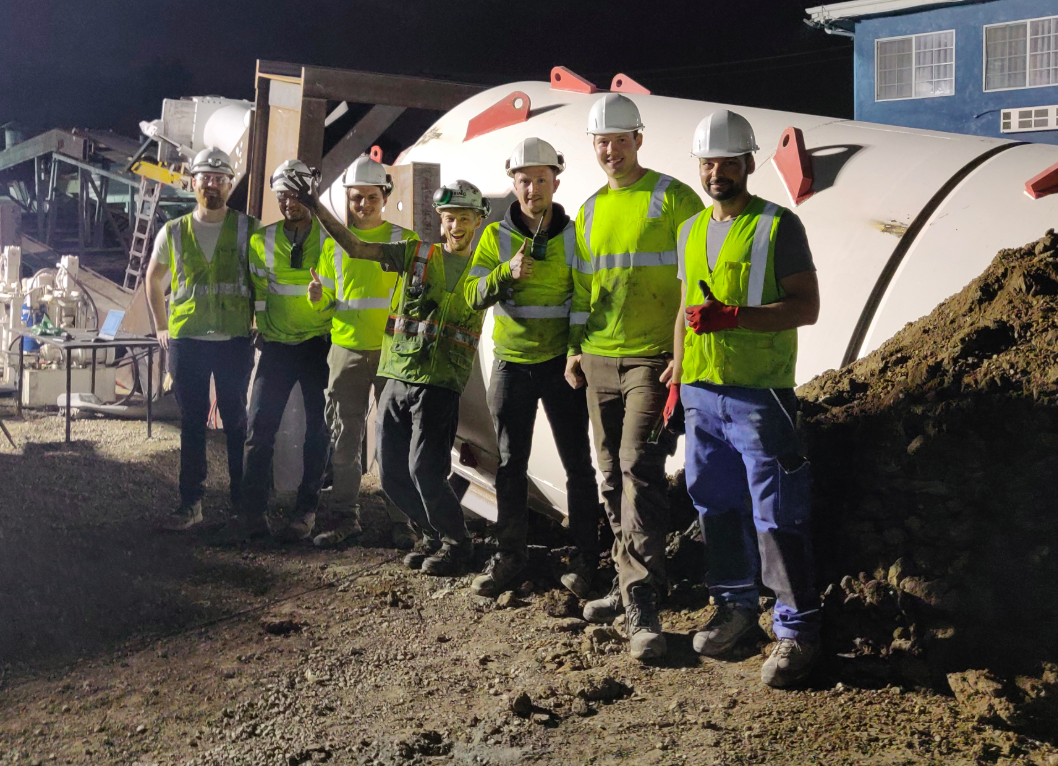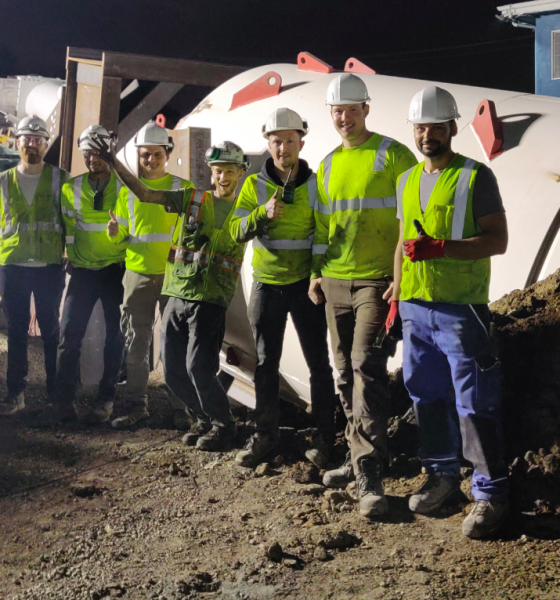

News
Elon Musk's Boring Company quietly deploys its custom-designed tunneling machine
As it turns out, Elon Musk’s tunneling startup, The Boring Company, has just completed and perhaps even deployed its custom-designed tunnel boring machine. The new digger features several innovations, and it could very well accelerate Musk’s vision of ultra-high-speed tunnels transporting vehicles and people through a vast network of tunnels underground.
The brief announcement was shared by the official Boring Company Twitter handle. The post was simple, showing a group of employees smiling in front of a tunnel boring machine that seems poised to start digging. In the tweet’s description, the startup posted the words “Prufrock is alive.”
This could very well be the biggest news to come out from the Boring Company since Elon Musk and TBC Head Steve Davis held an information session about the tunneling startup and its technologies at the Leo Baeck Temple in Los Angeles, CA back in May 2018. This is because unlike traditional tunnel boring machines (TBM), Prufrock is custom designed by The Boring Company, and it is expected to be capable of digging far quicker than its conventional counterparts.
The Boring Company started with Godot, a traditional boring machine that pretty much functions like a regular TBM. Godot is believed to be the boring machine that created the Hawthorne test tunnel, and while it works just as well as a TBM could, it is also immensely slow. Following Godot, the Boring Company designed Line-Storm, a TBM that is essentially a heavily modified conventional boring machine. In terms of speed, Line-Storm is capable of at least digging twice as fast as a traditional TBM like Godot.
But Godot and Line-Storm are just the beginning. During The Boring Company’s information session, Elon Musk and Steve Davis talked about a third tunneling machine. This machine, called Prufrock, is entirely designed by the startup, and it is expected to dig about 10-15 times faster than traditional boring machines like Godot. That’s a notable improvement over conventional diggers, and it has the potential to revolutionize tunneling technology in one fell swoop.
Elon Musk described each of the Boring Company’s TBMs as follows.
“Godot, which is the name of the first machine, is a conventional tunnel boring machine… So going from Godot to Line-Storm, Line-Storm is a highly modified boring machine, but it’s essentially a hybrid between a conventional boring machine and Prufrock, which is the fully Boring Company-designed machine. So Prufrock, that will be quite a radical change. Prufrock will be about ten times, aspirationally 15 times faster than current boring machines. I think very likely ten times.”
The Boring Company is involved in several projects, from the Dugout Loop in CA to the Las Vegas Convention Center tunnel in Nevada. Among these, the LVCC loop seems to be the most active, though the startup has not announced which of its machines had been deployed on the site. Considering that the TBM managed to complete the first of its two tunnels already, perhaps the machine digging under Las Vegas today is Line-Storm. As for Prufrock, the project where it will be deployed for the first time will likely be incredibly lucky.
The Boring Company’s potential disruption, after all, largely depends on how fast it could construct tunnels in a safe and efficient way. As noted by Elon Musk, this has a lot to do with the speed of TBMs themselves, as regular diggers move at a fraction of a snail’s pace. If The Boring Machine could at least match the speed of a snail, then a transport tunnel’s turnaround time would be drastically lower. This, of course, opens the doors to more tunnels being built, effectively ushering in Elon Musk’s vision of an ultra high-speed, underground future.

News
Elon Musk’s Grokipedia surges to 5.6M articles, almost 79% of English Wikipedia
The explosive growth marks a major milestone for the AI-powered online encyclopedia, which was launched by Elon Musk’s xAI just months ago.

Elon Musk’s Grokipedia has grown to an impressive 5,615,201 articles as of today, closing in on 79% of the English Wikipedia’s current total of 7,119,376 articles.
The explosive growth marks a major milestone for the AI-powered online encyclopedia, which was launched by Elon Musk’s xAI just months ago. Needless to say, it would only be a matter of time before Grokipedia exceeds English Wikipedia in sheer volume.
Grokipedia’s rapid growth
xAI’s vision for Grokipedia emphasizes neutrality, while Grok’s reasoning capabilities allow for fast drafting and fact-checking. When Elon Musk announced the initiative in late September 2025, he noted that Grokipedia would be an improvement to Wikipedia because it would be designed to avoid bias.
At the time, Musk noted that Grokipedia “is a necessary step towards the xAI goal of understanding the Universe.”
Grokipedia was launched in late October, and while xAI was careful to list it only as Version 0.1 at the time, the online encyclopedia immediately earned praise. Wikipedia co-founder Larry Sanger highlighted the project’s innovative approach, noting how it leverages AI to fill knowledge gaps and enable rapid updates. Netizens also observed how Grokipedia tends to present articles in a more objective manner compared to Wikipedia, which is edited by humans.
Elon Musk’s ambitious plans
With 5,615,201 total articles, Grokipedia has now grown to almost 79% of English Wikipedia’s article base. This is incredibly quick, though Grokipedia remains text-only for now. xAI, for its part, has now updated the online encyclopedia’s iteration to v0.2.
Elon Musk has shared bold ideas for Grokipedia, including sending a record of the entire knowledge base to space as part of xAI’s mission to preserve and expand human understanding. At some point, Musk stated that Grokipedia will be renamed to Encyclopedia Galactica, and it will be sent to the cosmos.
“When Grokipedia is good enough (long way to go), we will change the name to Encyclopedia Galactica. It will be an open source distillation of all knowledge, including audio, images and video. Join xAI to help build the sci-fi version of the Library of Alexandria!” Musk wrote, adding in a later post that “Copies will be etched in stone and sent to the Moon, Mars and beyond. This time, it will not be lost.”
News
Tesla Model 3 becomes Netherlands’ best-selling used EV in 2025
More than one in ten second-hand electric cars sold in the country last year was a Tesla Model 3.

The Tesla Model 3 became the most popular used electric car in the Netherlands in 2025, cementing its dominance well beyond the country’s new-car market.
After years at the top of Dutch EV sales charts, the Model 3 now leads the country’s second-hand EV market by a wide margin, as record used-car purchases pushed electric vehicles further into the mainstream.
Model 3 takes a commanding lead
The Netherlands recorded more than 2.1 million used car sales last year, the highest level on record. Of those, roughly 4.8%, or about 102,000 vehicles, were electric. Within that growing segment, the Tesla Model 3 stood far ahead of its competitors.
In 2025 alone, 11,338 used Model 3s changed hands, giving the car an 11.1% share of the country’s entire used EV market. That means more than one in ten second-hand electric cars sold in the country last year was a Tesla Model 3, Auto Week Netherlands reported. The scale of its lead is striking: the gap between the Model 3 and the second-place finisher, the Volkswagen ID3, is more than 6,700 vehicles.
Rivals trail as residual values shape rankings
The Volkswagen ID.3 ranked a distant second, with 4,595 used units sold and a 4.5% market share. Close behind was the Audi e-tron, which placed third with 4,236 registrations. As noted by Auto Week Netherlands, relatively low residual values likely boosted the e-tron’s appeal in the used market, despite its higher original price.
Other strong performers included the Kia Niro, the Tesla Model Y, and the Hyundai Kona, highlighting continued demand for compact and midsize electric vehicles with proven range and reliability. No other model, however, came close to matching the Model 3’s scale or market presence.
News
Tesla Model Y Standard Long Range RWD launches in Europe
The update was announced by Tesla Europe & Middle East in a post on its official social media account on X.

Tesla has expanded the Model Y lineup in Europe with the introduction of the Standard Long Range RWD variant, which offers an impressive 657 km of WLTP range.
The update was announced by Tesla Europe & Middle East in a post on its official social media account on X.
Model Y Standard Long Range RWD Details
Tesla Europe & Middle East highlighted some of the Model Y Standard Long Range RWD’s most notable specs, from its 657 km of WLTP range to its 2,118 liters of cargo volume. More importantly, Tesla also noted that the newly released variant only consumes 12.7 kWh per 100 km, making it the most efficient Model Y to date.
The Model Y Standard provides a lower entry point for consumers who wish to enter the Tesla ecosystem at the lowest possible price. While the Model 3 Standard is still more affordable, some consumers might prefer the Model Y Standard due to its larger size and crossover form factor. The fact that the Model Y Standard is equipped with Tesla’s AI4 computer also makes it ready for FSD’s eventual rollout to the region.
Top Gear’s Model Y Standard review
Top Gear‘s recent review of the Tesla Model Y Standard highlighted some of the vehicle’s most notable features, such as its impressive real-world range, stellar infotainment system, and spacious interior. As per the publication, the Model Y Standard still retains a lot of what makes Tesla’s vehicles well-rounded, even if it’s been equipped with a simplified interior.
Top Gear compared the Model Y Standard to its rivals in the same segment. “The introduction of the Standard trim brings the Model Y in line with the entry price of most of its closest competition. In fact, it’s actually cheaper than a Peugeot e-3008 and costs £5k less than an entry-level Audi Q4 e-tron. It also makes the Ford Mustang Mach-E look a little short with its higher entry price and worse range,” the publication wrote.








